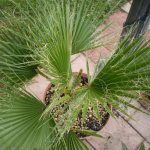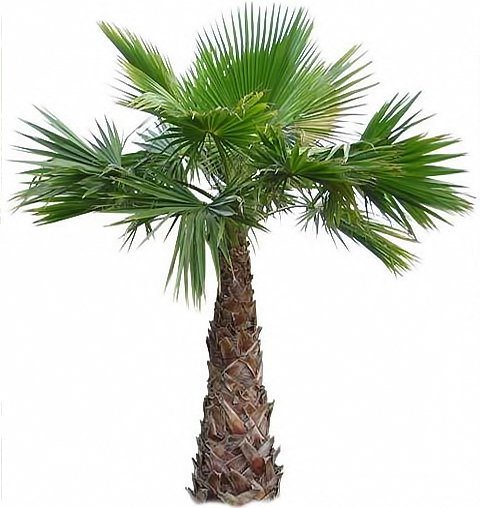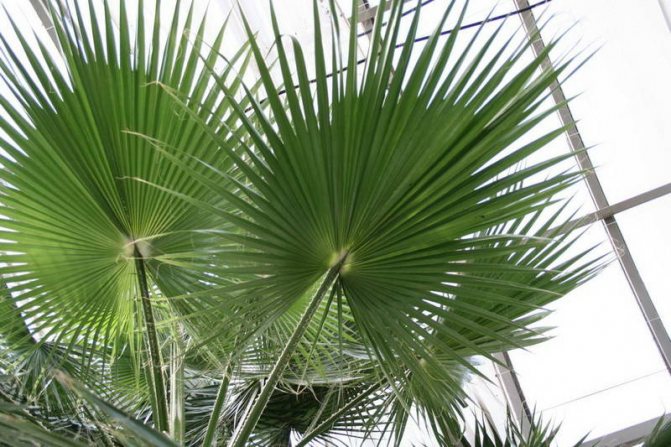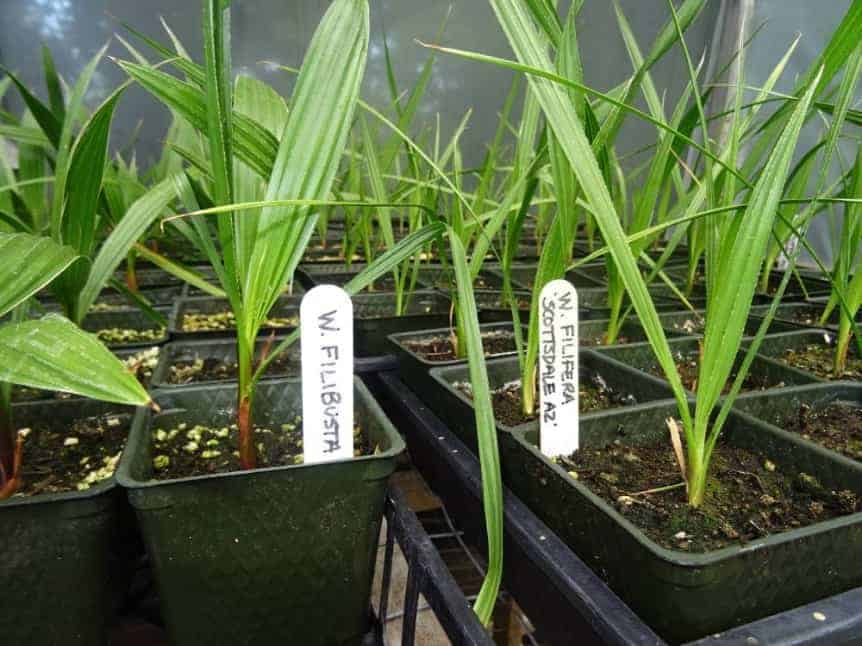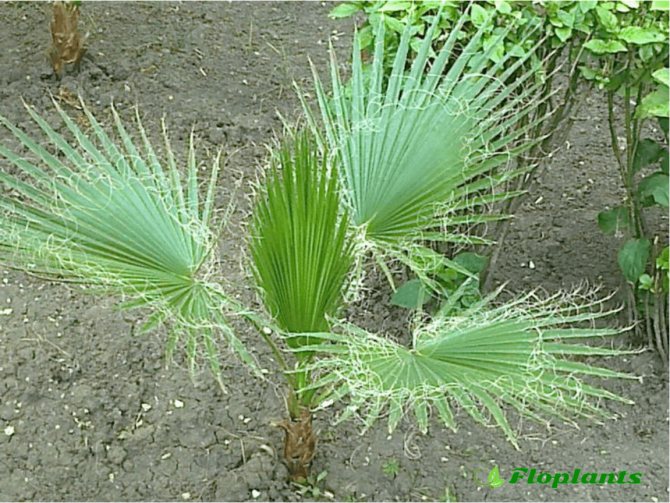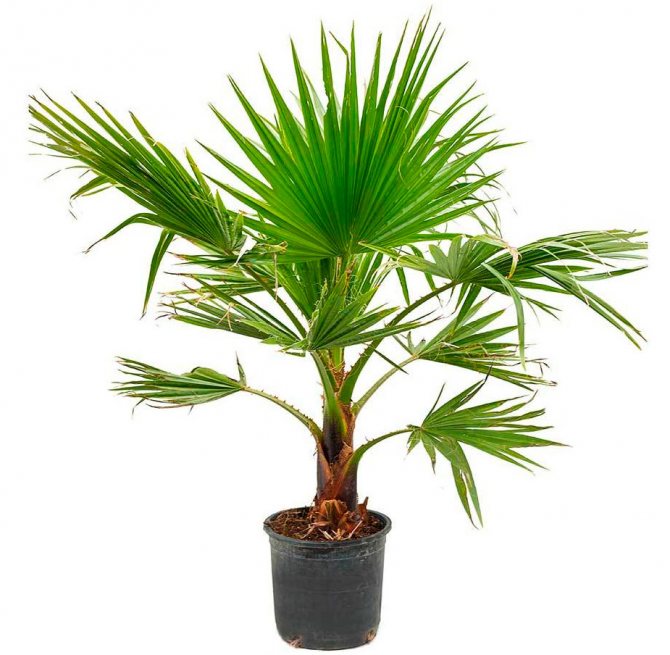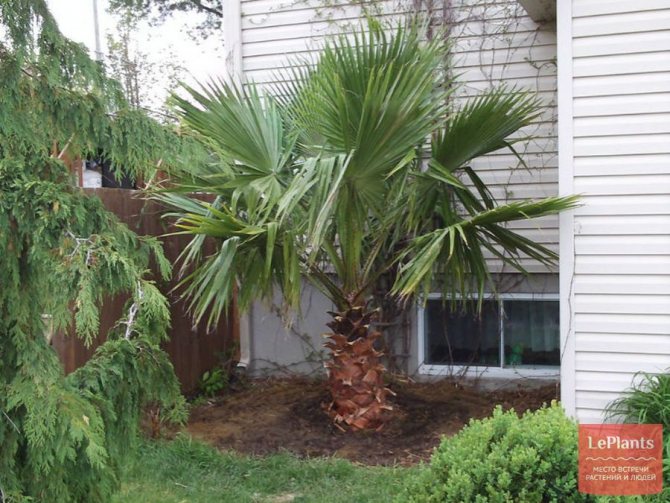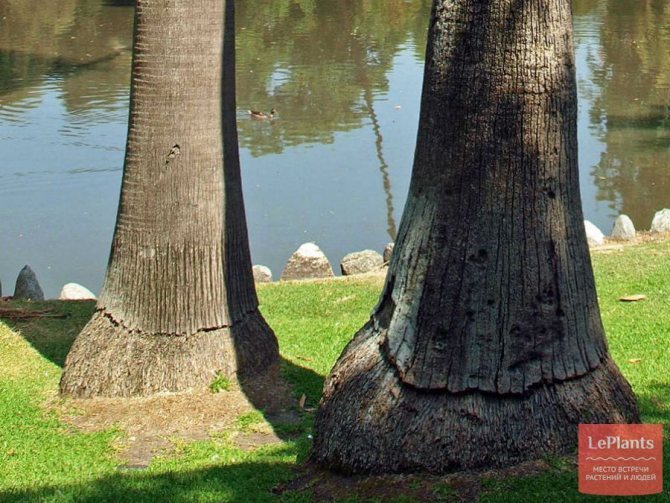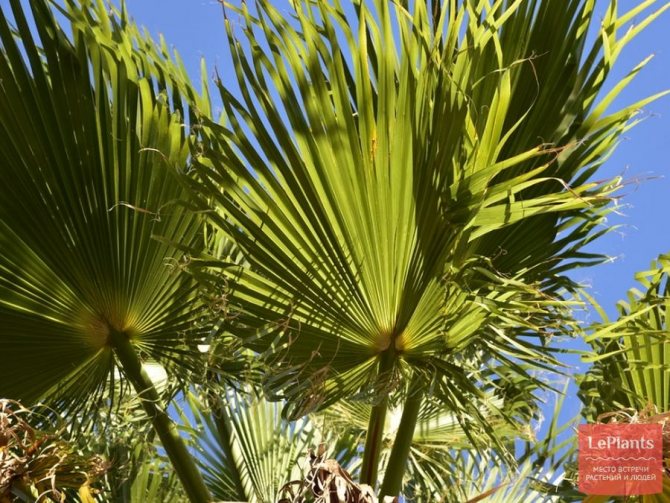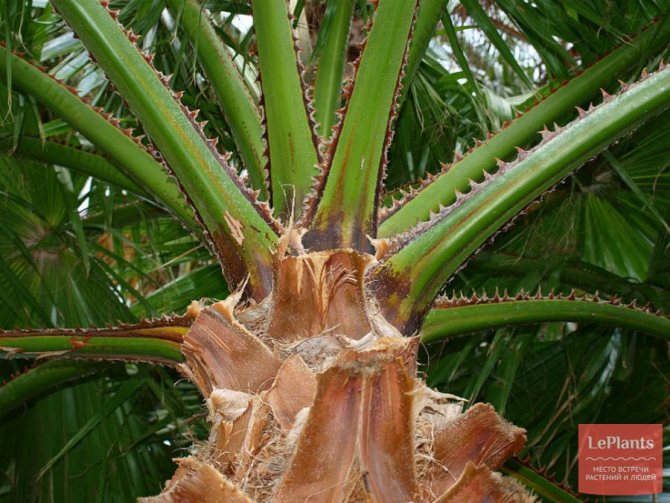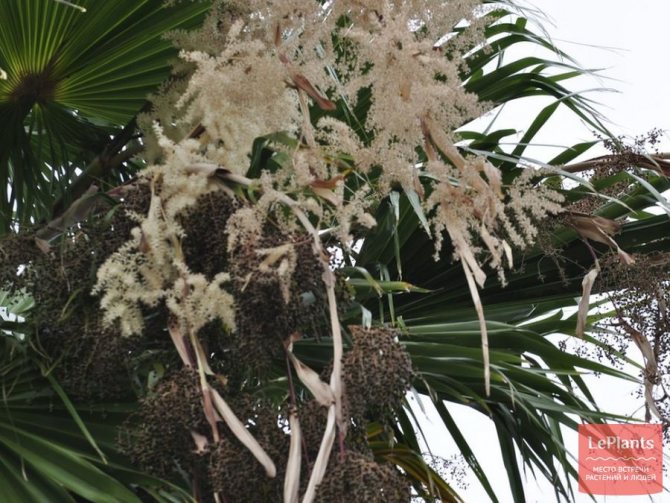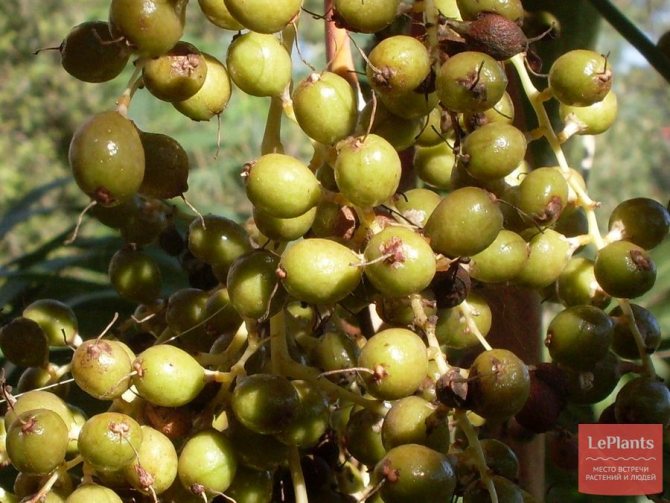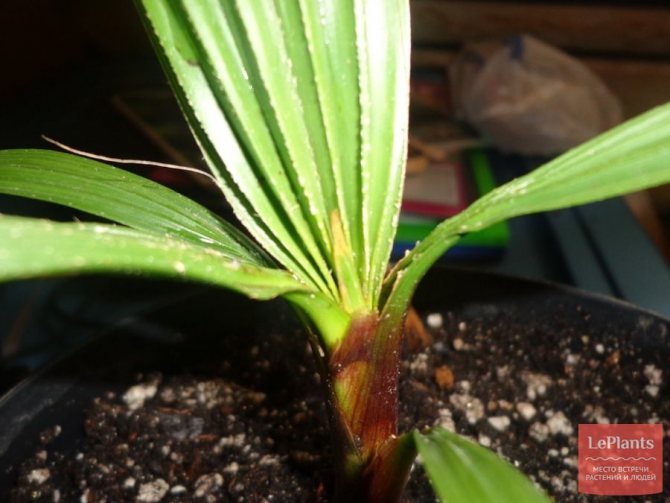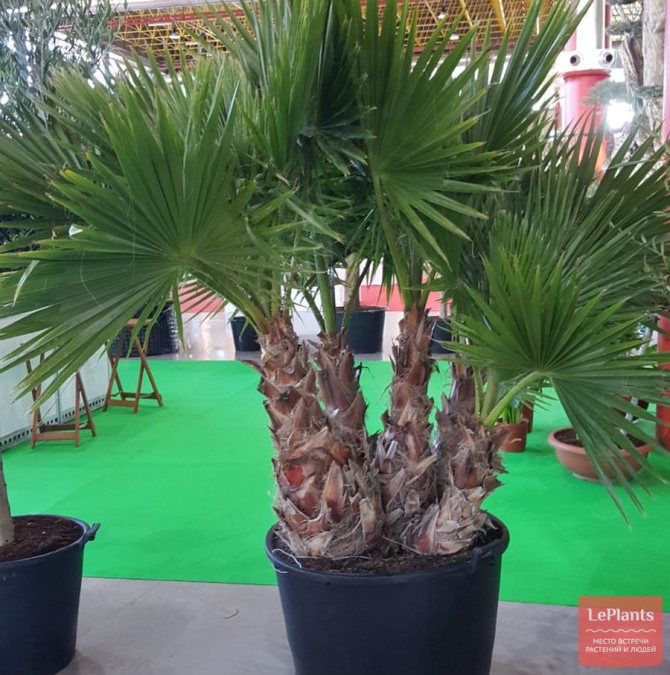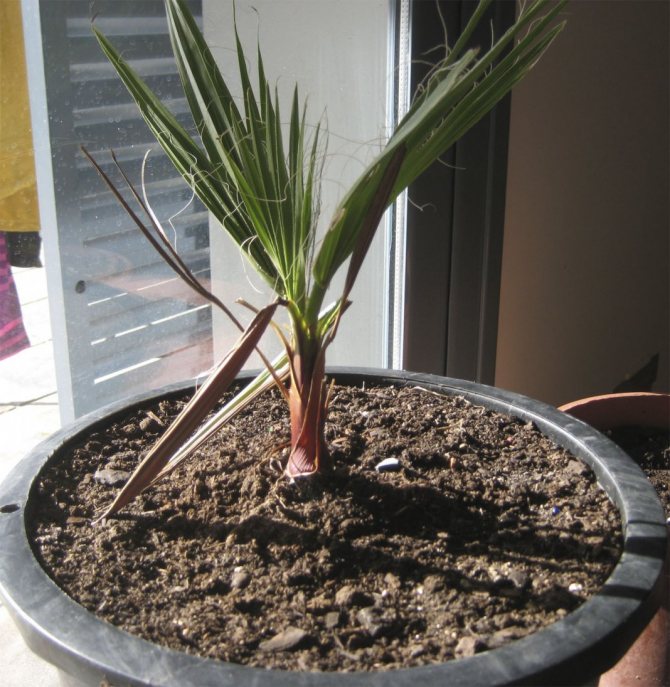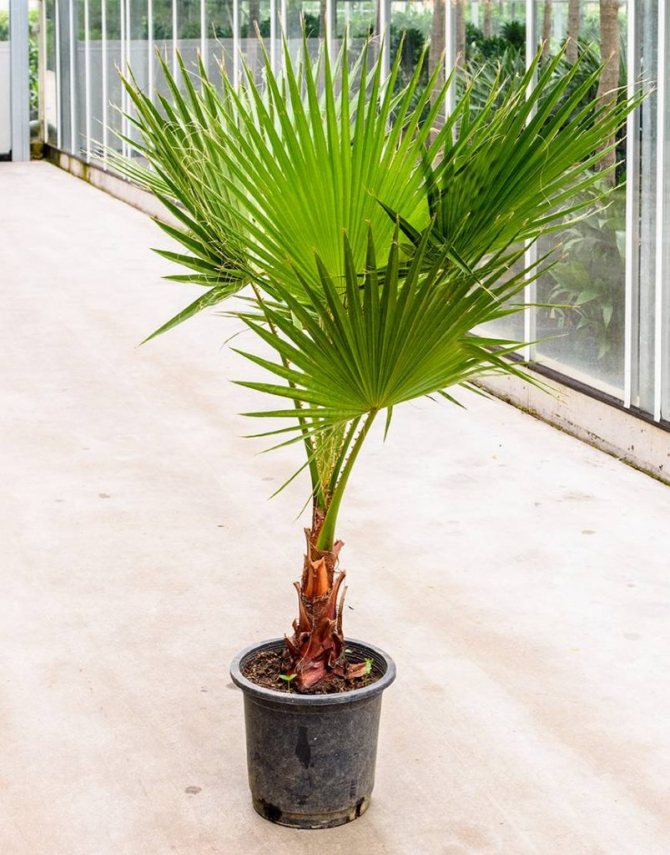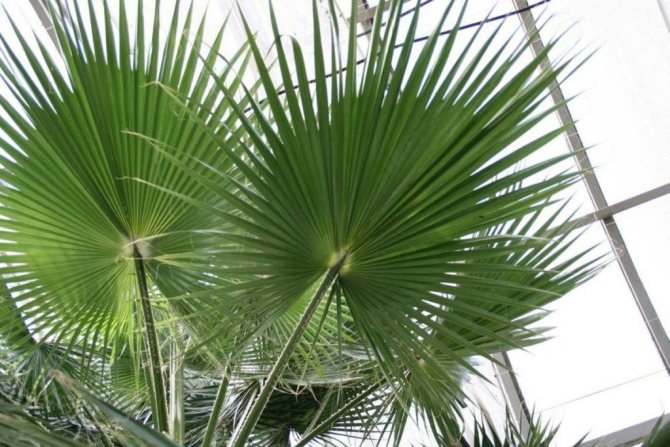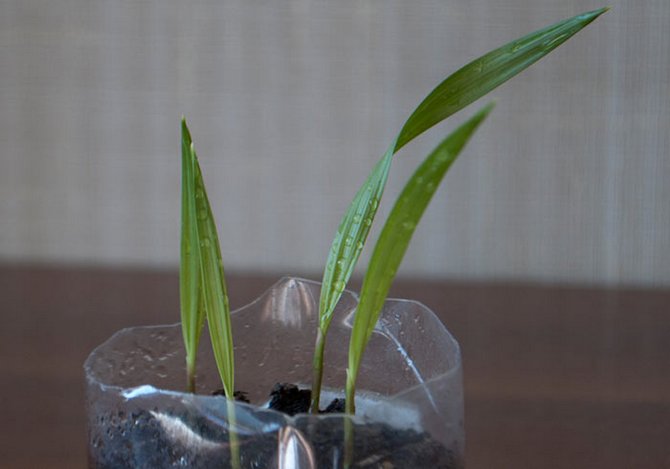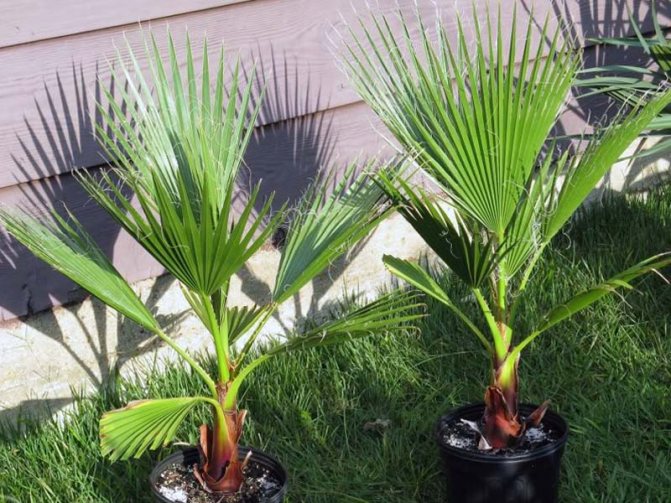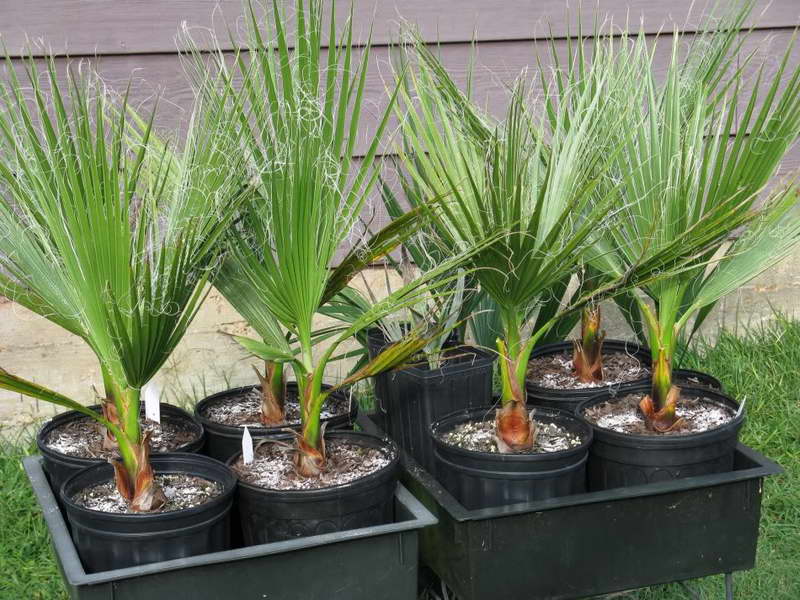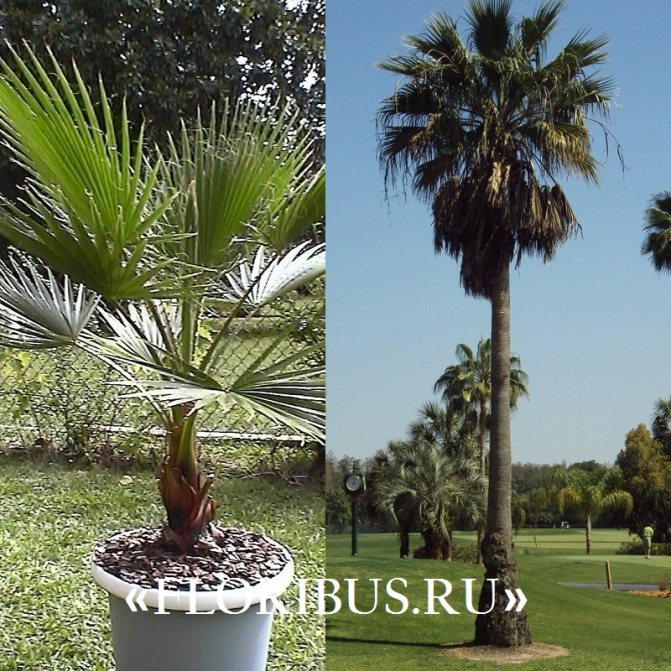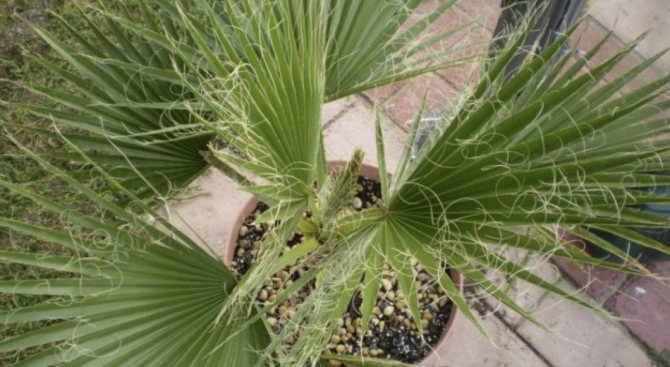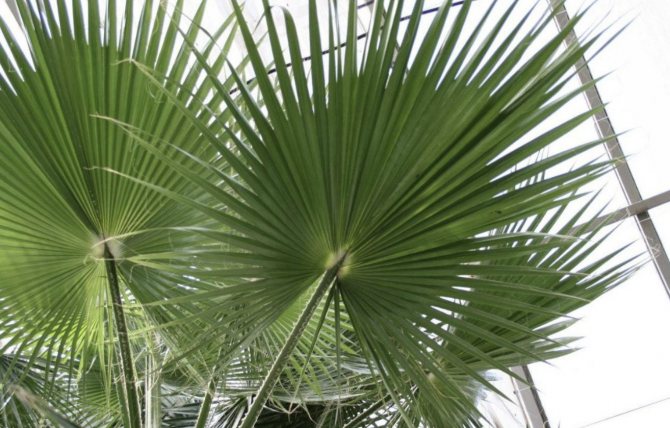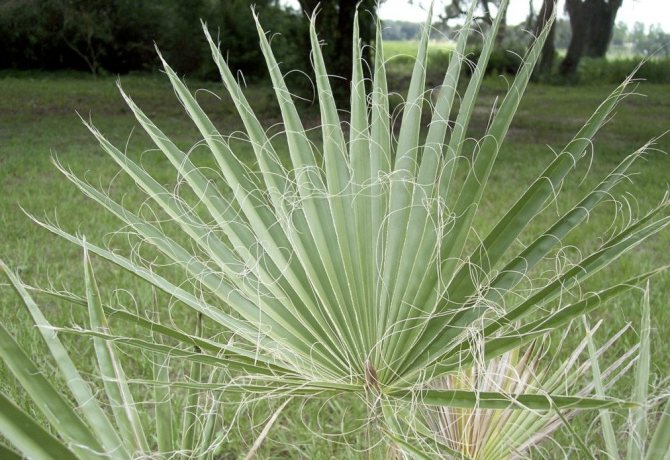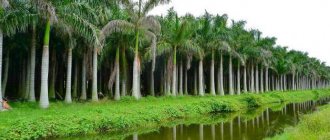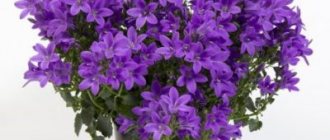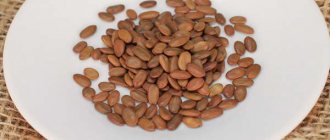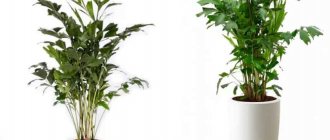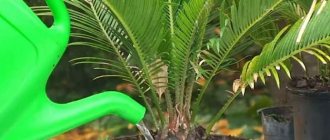| Russian name: | Washingtonia |
| Latin name: | Washingtonia |
| Family: | Palms (Arecaceae) - Palmae (Arecaceae) |
| Homeland: | Central America |
| Air humidity: | Moderate |
| Temperature: | Heat-loving |
| Lighting: | Bright light |
| Difficulty of growing: | It is advisable to have a little experience |
Useful properties of washingtonia
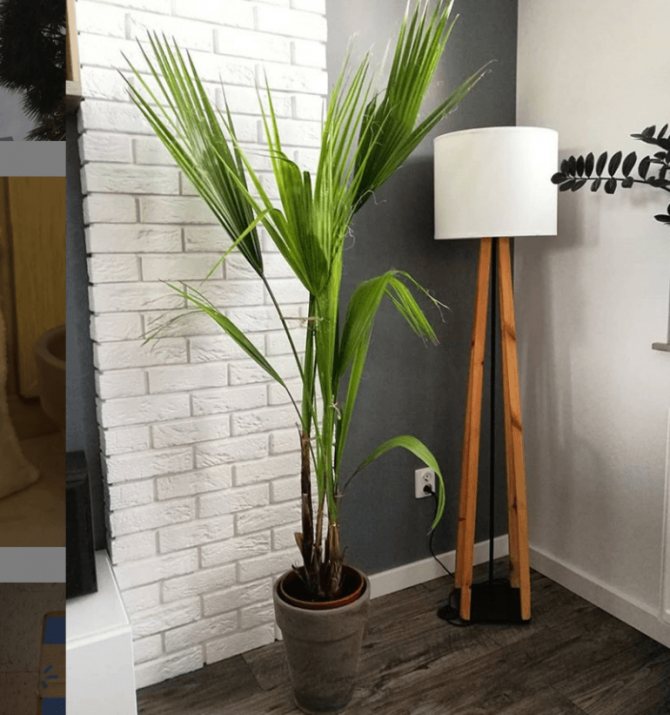
Due to its large leaf area, Washingtonia moisturizes the air well. Grown as an ornamental deciduous plant. The fan palm is not so common in indoor culture due to its large size. It is used for landscaping spacious rooms, offices, halls of hospitals and hotels, etc. Helps create a soothing, aesthetically pleasing environment.
Views
- Filament (or filamentous) - a blooming variety. The leaves in the form of large threads in a green plant have yellow edges and a white vein. The variety is classified as an evergreen monocotyledonous plant. Due to the presence of a fan-shaped stem and leaves, this palm is called a tree-like palm.
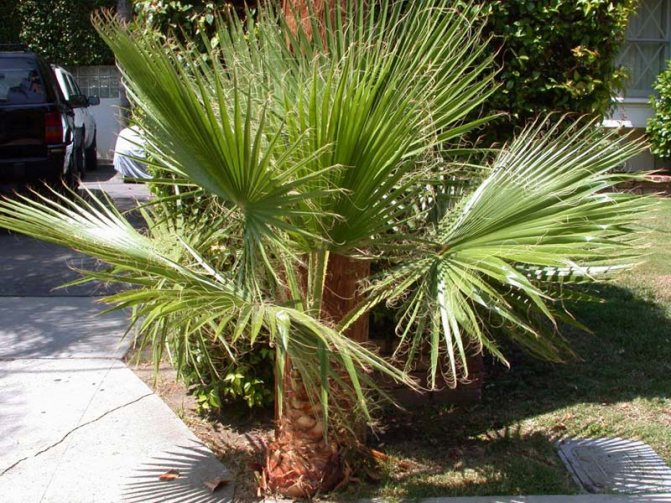

And in this video you will find even more information for yourself.
- Powerful (or Robusta) - a variety with a more elongated and thin trunk. The crown is much larger than the previous one, and the long leaves with brownish petioles bear fewer fibers.
You can view a detailed description, name and photo of the most common types of palm trees here.
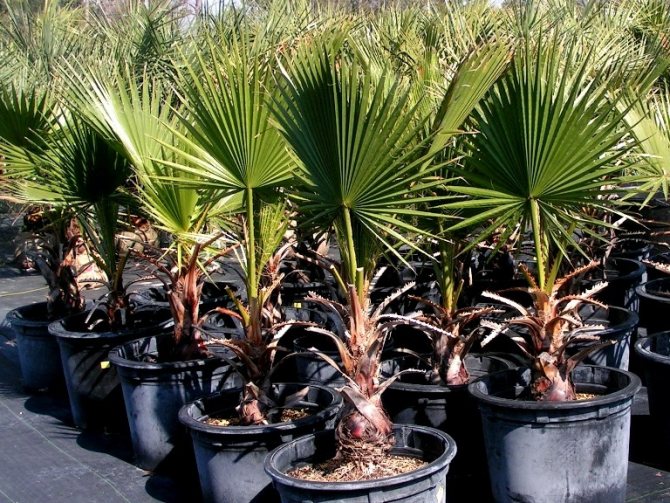

Features of home care. Briefly
Let's take a quick look at the basic requirements for growing Washingtonia at home:
| Temperature | Moderate: in winter not lower than 12 ° C, in summer - up to 25 ° C. |
| Air humidity | Increased. Spraying is required if kept in a heated room. |
| Lighting | Diffused light without direct sunlight. |
| Watering | Abundant in spring and summer. In winter, the soil is kept slightly moist. |
| Priming | Grows well in ready-made palm soil. Drainage is imperative. |
| Top dressing and fertilization | During the growth period from spring to autumn, liquid complex fertilizers are applied for palms. |
| Transfer | Carried out only if absolutely necessary, if the roots do not fit in the pot. Like all palm trees, Washington does not like to be disturbed. |
| Reproduction | The seeds are germinated under a film at a temperature not lower than 25 ° C. The time of appearance of the first leaf is 2-3 months after sowing. |
| Growing features | In summer, you can take it out into the open air. Shade from direct sun. |
A little about Washington
Washingtonia robusta (it is also Washingtonia powerful, strong, Sonoran and Mexican fan palm) is a tree-like perennial, one of two types of Washingtonia palm trees, which are characterized by:
- bright green leaves with sharp thorns on brownish petioles.
- compact crown.
- irregular (once every few years) flowering, in which numerous flowers of orange, pink and white are formed, which can reach up to 3 meters in length.
- spherical drupe fruit of blue-black or brown color with a diameter of 8 mm to 1 cm, appearing after flowering. The fruit is nutritious, so birds love it very much. There is evidence that its pulp is even eaten in places where Washingtonia robusta naturally grows.
- a dense shell of old leaves that do not fall off when dry, due to which Washingtonia is informally called "palm in a children's skirt."


The palm tree is distinguished by rapid growth, in its natural environment it can grow up to 30 meters, so if you started to grow it in a regular room, albeit with a high ceiling, then when it reaches the age of 5-6 years, it may well need to "move" to another room. At the same time, in a young tree, the leaves can reach a length of up to 120 cm, and the trunk itself after the final formation - up to 45 cm. Experts recommend, as it grows, unfold the palm tree relative to the light source so that the leaves cover it evenly. The ideal place for growing Washingtonia robusta at home is a spacious veranda, balcony, greenhouse or winter garden. One of its most popular varieties, convenient for growing in an apartment or house, is the Washingtonia Santa Barbara. Most often, it is he who is found in industrial premises as a gardener, since he is able to tolerate even moderate air pollution.
Caring for washingtonia at home: detailed instructions
In order for the cultivation to be crowned with success, it is necessary to comply with some requirements. Like other palms, Washingtonia at home needs a cool winter and humid air in the summer.
Bloom
At home, even under good conditions, the Washingtonia palm tree blooms extremely rarely. In nature, inflorescences are formed on the plant - long ears, exuding a strong aroma.
On the Black Sea coast, flowering occurs in June, fruit ripening in November.
Temperature regime
They maintain different temperatures in winter and summer. Optimum indicators: in summer 22-25 ° C without overheating, in winter - not lower than 12 ° C. In the summer, the plant is taken out to an open balcony or garden. Home washingtonia should be protected from frost and cold drafts.
Interesting! An adult plant growing outdoors can withstand temperatures as low as -5-6 ° C.
In the Russian climate, washingtonia grows outdoors on the Black Sea coast (Sochi). But even there she needs shelter for the winter.
Spraying
Washington needs humid air. Therefore, it must be regularly sprayed with warm water. It is better to do this in the morning, so that all the droplets dry out until the evening. Adult leaves are sometimes wiped with a damp sponge. In a heated room, a container with a plant is placed at a distance from the battery.
Advice! You can increase the air humidity next to the plant if you put a pot with a palm tree in a tray with wet expanded clay. Another option is to keep an open container of water near Washington.
Lighting
It is a mistake to think of Washington as a lover of the tropical sun. She needs bright, diffused light without direct sunlight. Partial shade is acceptable. To ensure such conditions, it is enough to keep a palm tree at a distance of 1.2-1.5 m from a sunny window or next to a western or eastern window.
Advice! If natural sunlight is not enough in winter, you need to provide the plant with artificial lighting.
Watering
Washington is watered sparingly, but all year round. Summer and spring are quite abundant, keeping the soil slightly moist at all times. In winter, watering is reduced: after the topsoil has dried to a depth of 1 cm, they wait another 1-2 days. The watering regime for cold wintering is reduced to 1-3 times a month.
The palm tree does not tolerate stagnant water at the roots. Therefore, overflow can lead to complete decay of the root system and the death of the plant. Excess moisture is especially dangerous in cold winter, when the absorbency of the roots decreases.
Pot for washingtonia
Washingtonia does not have special requirements for the pot. The selection parameters are standard. The size of the pot should correspond to the root system of the plant: when planting, 1.5-2 cm should remain between the earthen lump with the roots and the walls of the pot.When growing a palm tree from seeds, the first pot for a young sprout is taken with a diameter of 6-9 cm, gradually increasing its size with each transplant.
The choice between plastic and ceramic containers is based on the personal preference of the grower. The only requirement is that Washington needs good drainage, so the pot must have a hole in the bottom to drain excess moisture.
Interesting! Plants in ceramic pots require more frequent watering than plants in plastic pots. When changing from a plastic pot to a potter's pottery, washingtonia care at home needs to be adjusted.
Priming
The land is selected so that it passes water and air well to the roots. A special soil for palm trees from a trusted manufacturer is best suited. You can also make the soil yourself. To do this, you need turf, leafy and humus earth, sand in a ratio of 4: 2: 2: 1. Perlite or vermiculite is added to loosen the soil.
Top dressing and fertilization
Washingtonia requires regular feeding for good growth, as the nutrient content of the soil decreases over time. Fertilizers are applied in spring to autumn, that is, during the growth period. Do not feed in winter. They use complex mineral fertilizers for palms. If there are no such in the store, you can take a universal fertilizer for decorative deciduous plants.
The dose and frequency of application depends on the specific agent and is indicated by the manufacturer on the fertilizer package. It is usually sufficient to feed the palm tree every 10-14 days along with watering.
Important! Concentrated fertilization and no-water feeding can burn the roots and destroy the plant.
Washingtonia transplant
Like all palm trees, Washington is extremely sensitive to transplanting, so they should be carried out only if absolutely necessary. For the first 5 years of life, the plant is transplanted every 1-2 years into a larger pot.
An adult plant needs replanting if the roots have crawled out to the surface of the pot or sprouted through the drainage holes. Provide good care for Washington after transplant. In other cases, it is sufficient to change the topsoil annually.
A palm tree is transplanted in the spring, so that the roots have time to develop and adapt to the new pot before the onset of cold weather. Procedure:
- If the pot has been previously used, rinse it thoroughly. A new clay pot is soaked in water overnight.
- A drainage layer with a volume of up to ¼ of the pot must be poured onto the bottom of the container.
- The plant is watered and removed from the old container along with an earthen lump.
- Gently spread the lower roots with your hands, if possible.
- Place the palm tree on a layer of new earth in a new container, gradually filling in the gaps between the walls. The soil around the earthen coma is crushed.
- The plant is watered again and harvested for a week in the shade for adaptation. After that, they return to their usual place.
Pruning
As the palm grows, the lower leaves turn yellow and dry out. This is a natural process. Completely dried leaves are cut off.
Important! The only growth point for palms is at the top of the stem. If the stem is cut off, the plant will not shoot laterally and will die.
Dormant period
The plant does not have a pronounced dormant period. A seasonal feature of the content is compliance with the temperature and water regime.
If on vacation
In winter, you can leave the palm tree unattended for 1-2 weeks. Before leaving, the plant is watered and removed to the center of the room, away from bright light and heating appliances. In summer, it is better not to leave the palm tree unattended for longer than a week. If the vacation is longer, you can negotiate with friends or use automatic irrigation systems.
Botanical description and birthplace of the plant
Washingtonia is a perennial tree plant of the Arecaceae (Palm) family, named after the first president of the United States.
This is a typical palm tree. The erect trunk reaches a height of 20-30 m, it is almost smooth, but there are scars left by the petioles of dead leaves. At the top of the tree, fan-shaped leaf plates are cut into separate oblong segments, between which filamentous processes appear. Thanks to this feature, Washington is also called the cotton palm. By the way, dry leaves remain on the trunk for a long time (gardeners get rid of them in order to maintain decorativeness) and are a refuge for birds and rodents.
In nature, the palm is common in the southern United States and western Mexico.
The cold resistance of the plant (withstands a short-term drop in temperature to -5 ° C) makes it possible to use the palm tree to decorate parks, streets, household plots in regions with mild winters.
At home (this is what the article is devoted to), the Washingtonian palm tree is grown recently. She reveals her decorativeness in cool halls, winter gardens. Mostly young palms are grown in the room - up to the age of 7-8 years, in spacious rooms - up to about 15.
Growing Washingtonia from seeds
The plant is propagated only by seeds. You can buy them at specialized stores. Sowing is carried out in the spring and summer.
Procedure:
- To speed up the germination of seeds, the thick shell is lightly filed with sandpaper or a nail file, not reaching the inside. Then the seeds are soaked in warm water for 2-7 days. The water is changed daily.
- Soaked seeds are sown in a loose substrate from a mixture of earth with peat and sand to a depth of 1 cm.
- From above, the container is covered with foil or glass.
- The seeds are harvested in a warm place. For successful germination, a temperature of 25-30 ° C is required.
- The glass or film is removed daily to ventilate the container. The substrate is kept moist by spraying the surface.
- The sprouting rate depends on the freshness of the seeds. Young ones emerge in 15-20 days. The old ones germinate for 2-3 months.
- After seed germination, the container is moved to a bright, warm place.
- Seedlings dive into separate pots after 2 true leaves appear.
Growing conditions
Illumination
Many people mistakenly think that the palm tree likes to grow in direct sunlight, which is harmful to the plant. Lighting is required bright, but diffused: put Washington by the east or west window, the south window must be shaded with a tulle curtain.
Ideally, the duration of daylight hours should be 12-15 hours per day. In winter, it is necessary to use phytolamps or fluorescent lamps for illumination.
Air temperature and ventilation
For normal development, the palm needs fresh air. If possible, for the summer season, move to the balcony or garden, but protection from direct sunlight is necessary. Ventilate the room regularly, even in winter, while the plant should not be in a draft.
Keep the temperature regime warm. Protect from hypothermia when growing in a hall, conservatory or on a glazed balcony. In spring and summer, the optimal temperature range is 22-25 ° C, in winter - 10-12 ° C, but not lower than 5 ° C. Only an adult outdoor palm tree can withstand frost down to -5 ° C.
Diseases and pests
The main difficulties that growers face when growing a palm tree mainly happen with improper care:
- Washingtonia leaves turn yellow - insufficient watering or lack of nutrients. In summer, the roots of the palm tree should not dry out.
- Brown leaf tips - dry air. The plant needs to be sprayed more often. Lack of watering or cold air can also cause dry ends.
- Light dry spots on the leaves - excess light.
- To pour washingtonia wither and darken - too low air temperature.
- The apical kidney decays - overflow, too heavy waterlogged soil.
- Trunk decay - overflow, stagnation of water in the pot.
- The tips of the leaves dry - dry air and insufficient watering.
- Dark spots appeared on the leaves - Spotting is often associated with overflows or sudden drops in temperature. When dark spots appear, pests must be excluded (this can be a spider mite).
Of the pests, the palm is affected by spider mites, scale insects, mealybugs.
Washingtonia transplant video
Like all palm trees, Washingtonia does not tolerate transplanting very well. Perform the procedure in the spring. Transfer with an earthen clod so as not to damage the roots. Up to the age of 5, replant every 1-2 years, and older palms should be disturbed with a transplant when the roots literally begin to crawl out of the drainage holes. In any case, change the top layer of the substrate to a new one every year.
With each transplant, increase the diameter of the container slightly, it should be deep and stable: take a pot with a thickened bottom, for large Washingtonia - a tub.
Be sure to lay a drainage layer (expanded clay, perlite, pebbles, small non-sharp pebbles or a mixture of components), which should occupy ¼ of the total volume.
The soil requires moderately nutritious, loose, permeable to air and water. The best option would be to buy ready-made palm substrate at a flower shop. If you want to prepare the mixture yourself, you will need 4 parts of turf, 2 parts of leaf and humus soil and 1 part of sand. For adult plants, the proportion of humus should be increased.
Types of washingtonia home with photos and names
Washingtonia hairy or filamentary (Washingtonia filifera)


Palm tree up to 25 m high in natural conditions. When kept in a container, it grows up to 2-3 m. The leaves are fan-shaped, grayish-green. At the ends of the leaf segments, there are thin white filaments of fibers.
Washingtonia - record holder with huge fans
One of the largest and fastest growing palm trees that have been introduced into indoor culture, Washington conquers with its inimitable size. But its popularity was not at all ensured by the size. Unusual "details" - fibers, thorns, threads - make Washington stand out against the background of any other palm tree, along with the ideal structure of massive fan-shaped leaves, striking in their symmetry. This plant can only fit on a windowsill at a very young age: due to its growth rate, washingtonia becomes cramped in a small space in a matter of months.
The name of the palm tree, received in honor of George Washington, eloquently indicates its distribution area - North America, or rather, the southwest of the North American continent.
Washingtonia (Washingtonia) is called the most massive indoor palm tree for a reason, although many other giants are able to compete with it in superiority in size. It is not even the maximum possible growth of 3 m that makes the plant massive and large, but the size of the fan-leaves. Washingtonia has a rather low trunk, which, even at a considerable age, practically does not rise and seems modest in comparison with the height of the crown. It is rough and straight, with noticeable horizontal-toothed leaf traces, which hang down for a long time at the top and practically do not fall off without removal.
This is a classic fan-shaped palm tree in which huge rounded fans up to 2 m long look overwhelmingly massive. Cut only up to a third of the length into lanceolate segments, the size of which grows towards the center of the fan, they appear to be impeccable in shape. The visual coarseness of washingtonia leaves negatively affects the surrounding space, suppresses free space and can become a source of problems in small rooms with low ceilings.
But in spacious ones, you simply cannot find a better zoning accent and a giant with the same separating effect. But the main feature of Washington is not the size of the leaves at all.This plant has thorns on bare and rather short petioles, and along the edge of the fans, fibers that look more like threads stick out at all, giving this fan-shaped beauty a wild and slightly aggressive, but very unusual look. At the same time, the "disheveledness" of Washington does not give the impression of neglect or carelessness.
Washingtonia today on sale is represented mainly by species of plants. Washingtonia is powerful (Washingtonia robusta) - a beauty with a seemingly mirror-like, shiny surface of rich green leaves, devoid of fibers and filamentous formations, is inferior in popularity to the most popular washingtonia yarn (Washingtonia filifera) with its grayish fans adorned with long, hanging filaments at the edges. But both beauties deserve special emphasis in the rank of the most decorative large palms.
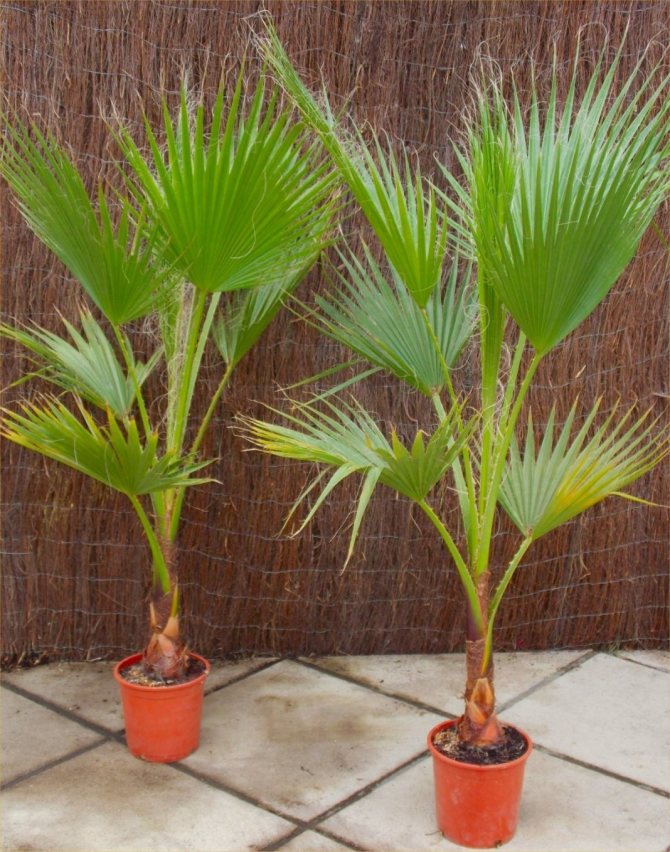

Washingtonia robusta in pots
Propagation of palm trees
Washingtonia in nature reproduces with the help of birds and wind. Fresh seeds that have fallen to the ground begin to germinate after a few days. Soon, sprouts appear in the shade of the old crown.
Feathery leaves do not grow immediately. First, the plant needs to get stronger. This is how nature protects the young palm tree from livestock that graze in arid pastures and destroy green shoots.
Washingtonia palm came to us from the USA and Mexico. But even in our latitudes, it can feel comfortable and delight the eye with its huge fan-shaped leaves. The plant is unpretentious to care for, but nevertheless, some rules must be adhered to. The main thing is to avoid direct sunlight, maintain optimal temperature and humidity, periodically feed, transplant and monitor the general condition of the room palm.
Watering, moisture and fertilization
- Watering should be optimal.
- But, its frequency is selected individually, depending on the conditions of detention in the room.
- Usually, flower growers monitor the drying of the earthy coma, or rather its top layer.
- When waterlogged, the roots of the plant begin to rot, and when dry, leaf plates fall off.
- When the soil dries up, the plant is watered with melted warm water - in spring and summer. IN
- in the winter season, moisture is introduced only 3-5 days after the soil has dried.
Humidity of the air, which should be high, is of great importance in the life and care of Washington. In order to maintain it, wipe the leaves several times a week with a damp cloth and spray the plant 2 times daily with melt water. If the leaf plates (young) begin to dry or their tips turn brown, this indicates that the plant does not have enough air humidity. The optimal indicator is in the range of 60-70%. To regulate it, place a vessel with water next to the pot or put wet sphagnum on the ground.
Fertilizers are used with a high content of iron compounds. The frequency of their introduction should be the same. Washingtonia is fed in the spring and autumn 2 times a month (Important, do equal intervals!). If the plant is sick, do not fertilize the season or until full recovery. After transplanting, conventional fertilizing mixtures are not used; instead, up to 5 kg of organic matter is added.
Washingtonia transplant is done only when needed. Large-sized devices are grown in wooden tubs and transplanted by the transfer method with an old earthen clod. For young plants up to 8 years old, a transplant is recommended every 2 years. After reaching this age, every 3 years. Adult plants, over 15 years old, every 4-5 years. When replanting, use a new soil mixture based on peat, which can be replaced with humus.
Interesting Facts
- The palm tree is a symbol of victory, therefore, in ancient times, the palm branch was awarded to the winners.
- Colombia and the island of Madagascar hold the record for the number of palm trees growing on their territory.
- In tropical countries, the plant is cultivated as a crop.
- In dry weather, the tree grows only at night.
- Their natural habitat is tropical and subtropical climatic latitudes.
- In the 60s of the last century, archaeologists discovered a pot of palm seeds. Their age was more than 2 thousand years. In the 21st century, scientists tried to grow a tree out of them. The attempt was crowned with success, and one of the seeds found sprouted.
Growing problems, pests
The indoor palm tree, like other plants, is susceptible to diseases and the negative effects of pests. There are several signs of the poor state of Washington:
- dark leaf tips indicate poor watering or a lack of potash fertilizers;
- dark leaves also appear due to a lack of moisture, in which case a pot with a palm tree is placed in a container of water and often sprayed;
- spotty leaves are a sign of temperature changes and excessive moisture;
- lethargic and dry leaves without signs of decay are a natural process of normal growth and development;
- curled foliage indicates the presence of harmful insects. Among the pests that infect the plant, the whitefly, the scale insect and the worm are isolated - in this situation, insecticides are used.
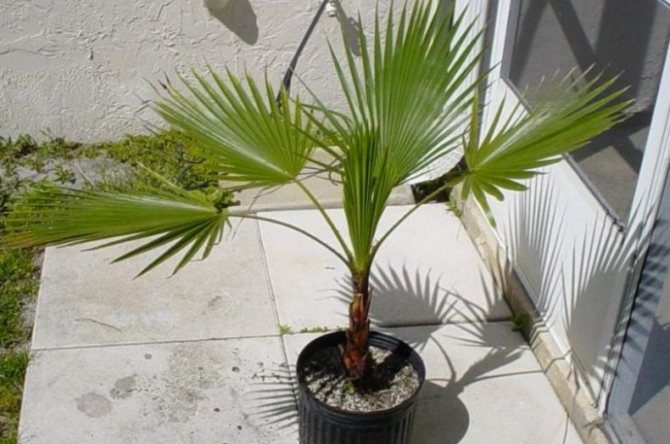

Where can one buy?
Washingtonia seeds can be bought at specialized retail outlets or on the Internet. It is important that the planting material is not damaged, fresh. If there is no desire, time and opportunity to independently grow Washingtonia from seeds, you can purchase a plant. The cost of a palm tree is determined by its type, age and size:
- washingtonia filamentous with a height of 70 cm costs about 1900 rubles;
- Washington filamentous 2 m - 47,000;
- washingtonia robusta 60 cm high - 1,700 rubles;
- washingtonia robusta 2 m - 43,000.
Caring for washingtonia is simple. By regularly devoting time to the plant, and by creating suitable conditions of detention, you can grow a real beauty with a fluffy crown, which will adorn any interior space.
Spectacular and beautiful composition
For those who want to get a beautiful composition at home, but do not want to spend a lot of time maintaining it, the Washingtonia palm tree is a decorative indoor culture. In the wild, the genus is found in North America, or rather in the subtropical zones of this continent. They refer it to the Palm family. In culture, the plant is actively used as an ornamental urban planting in Florida and California. In the wild, the plant mainly grows in groups in the lowlands of the subtropics, namely where there is access to groundwater.
In Florida, there are plantings that differ significantly from Californian growth. Botanists attribute this to climatic conditions. Florida experiences frequent thunderstorms, during which lightning strikes the trees overlooking the low vegetation of the state.
In Russia, the plant is actively cultivated in Sochi, Crimea, as well as in some parts of the Mediterranean. Washingtonia palm thrives well in dry climates and is easy to grow as a houseplant. In this issue we will learn how to get a spectacular composition by our own efforts, growing it from seeds.
Pest control
The biggest problem with growing this tree is its growth. Consider where you can place a mature plant when it reaches its maximum height. But that's not all. Also, the tree can suffer from pest attacks. You need to constantly monitor the state of the tree and respond to changes in time. The scale insect, mite and mealybug are the most frequent guests on the palm.
In addition, if watering is incorrect or temperature changes are allowed, the leaves of the plant can darken, curl up, and spots appear on them. The main thing in this case is to see the problem in a timely manner, assess the condition of the tree and eliminate it.In this case, the affected leaves are removed.
Photo gallery
Biological description


Washingtonia is a single-stemmed plant with a spreading fan-shaped crown. The upper part of the gray trunk is entwined with dried leaves and brown felt. The length of the leaf plate is 50 cm. Each palm leaf consists of elongated segments split from the base. Green leaves are tough to the touch. The length of paniculate inflorescences can reach three meters. The palm fruit is a small dark-colored drupe.

